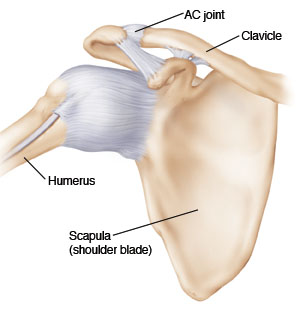AC Joint Sprain (Adult)

The AC or acromioclavicular joint is at the end of the collarbone, or clavicle, near the shoulder. The AC joint is made of four ligaments that hold the collarbone to the shoulder blade, or scapula. With an AC joint sprain, these ligaments may be partly or fully torn. In both cases, this causes pain and swelling at the end of the collarbone. If the ligaments are completely torn, the collarbone will rise up.
AC joint sprains are given a grade depending on whether they are mild, moderate, or severe.
-
Grade 1. A mild sprain, with minor damage to the ligaments. The collarbone stays in place.
-
Grade 2. A moderate sprain. The ligaments are partly torn. The collarbone is moved out of place. The injured shoulder may look lower and flatter than the other shoulder.
-
Grade 3. The most severe kind of sprain. The ligaments are completely torn. The collarbone is no longer joined to the shoulder blade. The collarbone rises up. This creates a bump on top of the shoulder. The ligaments heal in this position, so the bump doesn't go away. It's possible to have surgery to correct the bump. But normal shoulder function will usually return even without surgery.
An AC sprain will take up to 6 weeks or longer to heal, depending on how severe it is. It's often treated with a sling. Sometimes a sling and an elastic wrap around the chest may be used. Physical therapy may be needed to help the shoulder keep full range of motion. After it's healed, you can usually expect full recovery of shoulder function.
Home care
-
Your health care provider may prescribe medicines for pain. Or you may use over-the-counter pain medicines. Talk with your provider before taking medicines if you have chronic liver or kidney disease. Also talk with your provider if you've ever had a stomach ulcer or digestive bleeding or if you take a blood thinner.
-
Make an appointment right away to see your provider or an orthopedic doctor for further evaluation and treatment of the injury.
-
Use the injured area as little as possible. This will help decrease pain and swelling and allow the area to heal.
-
Place an ice pack over the injured area for 15 minutes. Do this every 4 to 6 hours for the first 24 to 48 hours, or as directed. Keep using ice packs to ease pain and swelling as directed by your provider or the orthopedic doctor.
-
To make an ice pack, put ice cubes in a plastic bag that seals at the top. Wrap the bag in a clean, thin towel or cloth. Never put ice or an ice pack directly on the skin. The ice pack can be put right on the wrap or sling. As the ice melts, be careful not to get the wrap or sling wet.
-
A sling alone is often enough. Sometimes a sling and a wrap around the chest may be used to help ease pain, if needed. This also helps keep your injured arm from moving. Use these devices as advised until you are seen by your health care provider or the orthopedic doctor. Always ask when the wrap should be worn. Always ask when the wrap can be removed.
-
Wear the sling while awake or as advised, until you are scheduled to see your provider or an orthopedic doctor. You may remove the sling to sleep. You may remove the sling to bathe. Make sure the sling is comfortable and keeps your arm raised, as advised by the provider. Follow the provider’s instructions on how to use the sling. Always ask when you should wear the sling. Always ask when the sling can be removed.
-
Shoulder joints become stiff if they are kept still for too long. Talk with your provider or the orthopedic doctor about range of motion exercises and possible physical therapy.
Follow-up care
Follow up with your health care provider, or as advised. Your provider may refer you to a specialist such as an orthopedic doctor. This is a provider who specializes in bones, joints, ligaments, and nerves.
If X-rays were taken, you will be told of any new findings that may affect your care.
When to seek medical advice
Contact your health care provider right away if:
-
Your shoulder looks off-balance.
-
You have increased pain, swelling, or bruising.
-
You have increased pain even after using prescribed pain medicine.
-
You have continuing pain.
-
Your hand or arm becomes cold, blue, numb, or tingly.
-
You have trouble moving your shoulder, wrist, or elbow due to stiffness.